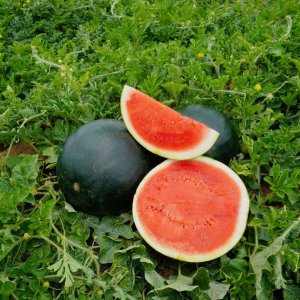Watermelons are synonymous with summer, picnics, and refreshing sweetness. Among the many varieties of watermelons, the Black Diamond watermelon stands out as a particular favorite for its size, flavor, and striking appearance. This article delves into the characteristics, cultivation, and uses of the Black Diamond watermelon, offering a comprehensive guide for enthusiasts and gardeners alike.

Origins and Characteristics
The Black Diamond watermelon is a cultivar that has been cherished by gardeners and consumers for decades. It was developed in the mid-20th century and quickly gained popularity due to its unique qualities. This variety is often recognized by its large size, thick rind, and deep green, almost black, outer skin, which gives it its name.
Black Diamond watermelons can weigh anywhere between 20 to 50 pounds, with some even reaching up to 75 pounds under optimal growing conditions. The flesh of the Black Diamond is a vibrant red, known for its juicy texture and sweet flavor. The seeds are typically large and black, though seedless varieties have also been developed.
Cultivation and Growing Conditions
Growing Black Diamond watermelons requires attention to detail and the right environmental conditions. This variety thrives in warm climates, making it a popular choice in regions with long, hot summers. Here are some essential tips for cultivating Black Diamond watermelons:
- Soil Preparation: Black Diamond watermelons prefer well-drained, sandy loam soil with a pH between 6.0 and 7.0. It’s essential to prepare the soil by tilling it to a depth of about 12 inches and incorporating organic matter to improve fertility and drainage.
- Planting: Black Diamond watermelons are typically grown from seeds. The seeds should be planted in hills or rows, with each hill containing about 3 to 4 seeds spaced 2 to 3 feet apart. The seeds should be sown 1 inch deep in warm soil, with soil temperatures above 70°F (21°C) for optimal germination.
- Watering: Consistent watering is crucial during the growing season, especially during the fruiting period. However, overwatering should be avoided as it can lead to waterlogged soil and root rot. Drip irrigation is recommended to maintain soil moisture while keeping the foliage dry, which helps prevent fungal diseases.
- Fertilization: Black Diamond watermelons benefit from regular feeding with a balanced fertilizer. It’s advisable to start with a fertilizer high in nitrogen to promote healthy vine growth and then switch to a phosphorus and potassium-rich fertilizer once the fruit begins to set.
- Pest and Disease Management: Like other watermelon varieties, Black Diamonds are susceptible to pests such as aphids, cucumber beetles, and squash bugs. Regular monitoring and the use of organic or chemical pest control methods can help protect the plants. Fungal diseases like powdery mildew and anthracnose can be managed through proper spacing, crop rotation, and the use of fungicides if necessary.
- Harvesting: Black Diamond watermelons are typically ready for harvest 90 to 100 days after planting. The fruit is ripe when the underside, where it rests on the ground, turns from white to a creamy yellow. Another indicator is the tendril nearest the fruit, which turns brown and dries out.
Culinary Uses and Nutritional Benefits
The Black Diamond watermelon is prized not only for its size but also for its sweet, refreshing flavor, making it a versatile ingredient in various culinary applications. Here are some popular ways to enjoy Black Diamond watermelon:
- Fresh Slices: The most straightforward way to enjoy Black Diamond watermelon is by cutting it into slices or wedges. Its juicy, sweet flesh is perfect for a refreshing snack on a hot day.
- Salads: Watermelon salads are a delightful summer dish. Pairing Black Diamond watermelon with ingredients like feta cheese, mint, and cucumber creates a sweet and savory combination that’s both refreshing and satisfying.
- Smoothies and Juices: Black Diamond watermelon can be blended into smoothies or juiced for a hydrating drink. Its high water content makes it an excellent base for beverages, especially when combined with other fruits like strawberries, pineapple, or lime.
- Grilled Watermelon: Grilling watermelon is an unconventional but delicious way to enjoy this fruit. The heat caramelizes the sugars in the watermelon, adding a smoky depth of flavor that pairs well with grilled meats or as a standalone side dish.
- Desserts: Watermelon can be used in a variety of desserts, from sorbets and popsicles to more elaborate creations like watermelon cake or granita. Its natural sweetness reduces the need for added sugars, making it a healthier dessert option.
From a nutritional standpoint, Black Diamond watermelon is low in calories and high in essential nutrients. It’s an excellent source of vitamins A and C, which are important for immune function, skin health, and vision. The fruit is also rich in antioxidants, particularly lycopene, which has been linked to reduced risk of certain cancers and heart disease. Additionally, its high water content makes it a hydrating snack, perfect for staying cool and refreshed during the summer months.
Conclusion
The Black Diamond watermelon is more than just a fruit; it’s a symbol of summer, a culinary delight, and a rewarding plant to grow in the garden. Its large size, striking appearance, and sweet flavor make it a favorite among watermelon enthusiasts and gardeners alike. Whether enjoyed fresh, in a salad, or as part of a more elaborate dish, the Black Diamond watermelon continues to be a cherished variety that stands the test of time.
For gardeners, the challenge of growing such a substantial fruit is well worth the effort, as the reward is a bountiful harvest of delicious watermelons that can be shared with family and friends. As a nutritional powerhouse, the Black Diamond watermelon offers a healthy, refreshing option that can be enjoyed in a multitude of ways, making it a true gem in the world of fruits.
